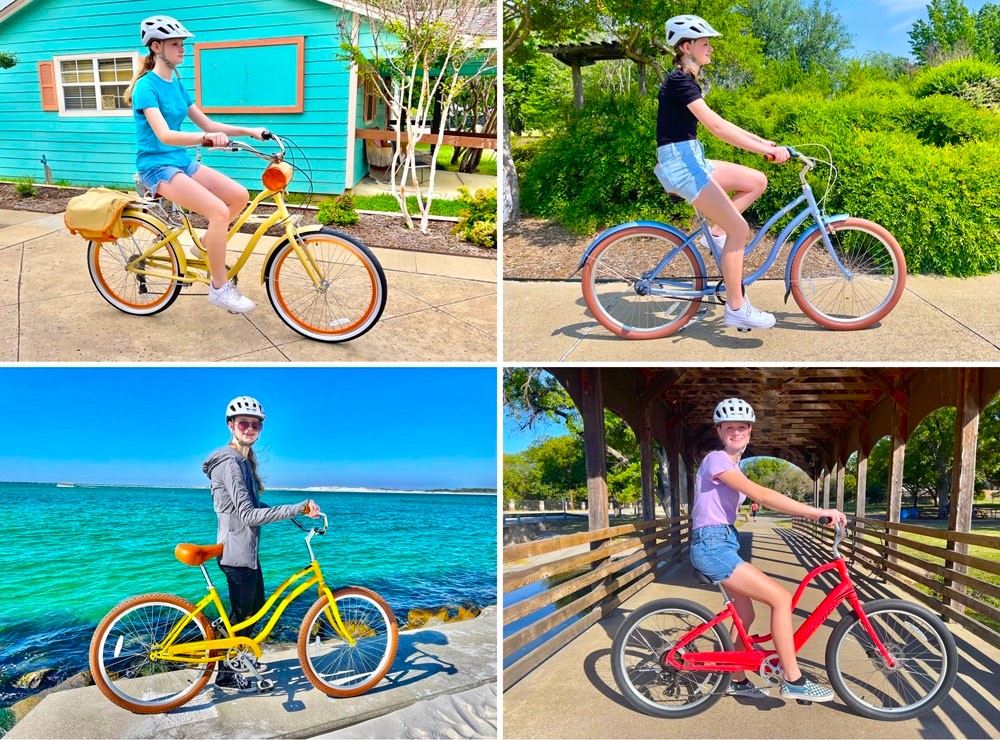Cruiser bikes and beach cruisers, with their laid-back riding style and classic good looks, are popular choices for cyclists who prioritize comfort and leisure over speed and performance. But are they the same? Let’s delve into the world of cruisers and explore the subtle differences between these two bicycle styles.
Cruiser Bikes: Comfort on Two Wheels
The quintessential cruiser bike boasts an upright riding position, achieved through a high handlebar and a relaxed seat angle. This upright posture promotes better visibility on the road and takes the strain off your back and shoulders, making it ideal for cruising around town or enjoying a scenic ride.
Comfort is king with cruiser bikes. They typically feature:
- Wide, balloon tires: These tires provide excellent shock absorption, smoothing out bumps and creating a comfortable ride, even on less-than-perfect pavement. However, the wider surface area also creates more drag, so don’t expect to win any speed races.
- Plush saddles: Cruiser saddles are designed for maximum comfort, often featuring ample padding and springs for added vibration dampening.
- Simple drivetrain: Most cruisers are single-speed or have a few gears, making them easy to maintain and perfect for casual riding.
- Steel frame: Steel is a popular frame material for cruisers due to its durability, affordability, and smooth ride quality.
Related: Top 9 Best Kaluna Beach Cruiser Bikes for Men/Women 2024
Beach Cruisers: Taking Comfort to the Coast
Beach cruisers are a sub-category of cruiser bikes, specifically designed for laid-back rides along the boardwalk or beach paths. They share many of the core features of cruisers, but with a few beach-ready twists:
- Fatter tires: Beach cruisers often have even wider tires than regular cruisers, providing extra traction on soft sand.
- Corrosion-resistant materials: Since beach environments expose bikes to salt and moisture, beach cruisers frequently use stainless steel or aluminum components for better durability.
- Fenders and rustproofing: Many beach cruisers come equipped with fenders to shield you from spray and rustproofing measures to combat the corrosive coastal elements.
- Aesthetics: Beach cruisers often embrace a more whimsical and colorful aesthetic, reflecting their carefree, coastal vibe.
Choosing Your Cruiser: It’s All About Your Ride
Whether you opt for a classic cruiser or a beach-ready variant depends on your riding preferences:
- For casual rides around town, errands, or leisure cycling on paved paths, a regular cruiser is a perfect choice.
- If your cycling adventures frequently take you to the beach, a beach cruiser with its fatter tires and corrosion resistance will be a more suitable companion.
Beyond Cruisers: Exploring Other Comfort-focused Options
The world of comfort cycling extends beyond cruisers. Here are some other options to consider:
- Hybrid bikes: Offering a blend of cruiser comfort with some performance features like multiple gears, hybrid bikes are a versatile choice for commuting and leisure rides.
- Comfort bikes: Designed with an emphasis on comfort, these bikes often share features like upright handlebars and wide seats with cruisers, but may have a lighter frame material or more gears.
Cruising in Style: Pros and Cons of Cruiser Bikes
Cruiser bikes, instantly recognizable by their laid-back riding position and classic looks, are a popular choice for cyclists who prioritize comfort and leisure over speed and performance. But like any bike style, they come with their own set of advantages and disadvantages. Let’s take a closer look at the pros and cons of cruiser bikes to help you decide if they’re the right fit for you.
Pros of Cruiser Bikes:
- Comfort is King: The hallmark feature of cruisers is their focus on comfort. The upright riding position with a high handlebar and relaxed seat angle keeps your back and shoulders happy, especially on longer rides. Wide, balloon tires soak up bumps and provide a smooth ride, even on rough roads. Plus, plush saddles with springs further enhance comfort.
- Easy to Maneuver: Cruiser bikes are generally stable and predictable, making them easy to handle for riders of all experience levels. The simple drivetrain, often single-speed or with few gears, is user-friendly and requires minimal maintenance.
- Durable Construction: Cruiser bikes are typically built with sturdy steel frames, ensuring durability and longevity. This makes them a good choice for everyday use and recreational riding.
- Style and Customization: Cruiser bikes have a timeless aesthetic that never goes out of fashion. Many models offer customization options, allowing you to personalize your ride with accessories like baskets, fenders, or different handlebars.
- Upright Visibility: The upright riding position on a cruiser bike offers excellent visibility on the road, making you more noticeable to motorists.
Cons of Cruiser Bikes:
- Not Built for Speed: Cruiser bikes prioritize comfort over speed. Their wide tires and relaxed geometry create more drag, making them less efficient for fast riding or conquering hills.
- Limited Gear Options: Most cruisers have a single speed or a few gears, making them less suitable for tackling varied terrains or inclines.
- Weight: Steel frames, while durable, can make cruisers heavier compared to bikes designed for performance. This can be a disadvantage for maneuvering in tight spaces or carrying the bike for short distances.
- Lower Ground Clearance: The low seat height and relaxed frame of cruisers can limit their ground clearance. This might be an issue when navigating uneven terrain or obstacles.
Who Should Consider a Cruiser Bike?
Cruiser bikes are a great choice for cyclists who:
- Prioritize comfort and a relaxed riding experience.
- Enjoy casual riding around town, on paved paths, or for leisure cycling.
- Appreciate a classic and timeless aesthetic.
- Want a low-maintenance and user-friendly bike?
Related: The Top 10 Best Beach Cruiser Bikes of 2024
Beach Bums Rejoice! Pros and Cons of Beach Cruisers
Beach cruisers, a subclass of cruiser bikes, are the epitome of laid-back coastal style. Designed for cruising the boardwalk or tackling sandy paths, they offer a comfortable ride with a touch of beach flair. But are they the perfect fit for every cyclist? Let’s delve into the advantages and disadvantages of beach cruisers to help you decide if they’re your ideal wave riders.
Pros of Beach Cruisers:
- Conquering the Coast: Beach cruisers are built to handle the beach environment. Their wide, fat tires provide excellent traction on soft sand, preventing you from getting stuck and ensuring a smooth ride.
- Corrosion Resistance: Unlike regular cruisers, beach cruisers often come equipped with stainless steel or aluminum components to resist the corrosive effects of salt water and salty air, a must for those frequent coastal rides.
- Fenders for the Win: Many beach cruisers boast built-in fenders that shield you from splashes and sand spray, keeping your clothes clean and your ride enjoyable.
- Rustproofing Measures: Manufacturers often take extra steps to rustproof beach cruisers, further protecting them from harsh coastal elements.
- Beach-Ready Style: Beach cruisers embrace a fun and colorful aesthetic, reflecting the carefree vibe of coastal living.
Cons of Beach Cruisers:
- Limited to Smooth Terrain: While beach cruisers excel on sand and boardwalks, their wide tires and relaxed geometry make them less suitable for tackling hills, rough terrain, or long-distance rides.
- Heavier Than Regular Cruisers: The addition of corrosion-resistant materials and wider tires can make beach cruisers heavier than standard cruisers. This can be a disadvantage for maneuvering in tight spaces or carrying the bike for short distances.
- Not Exactly Speed Demons: Just like regular cruisers, beach cruisers prioritize comfort over speed. Their design creates more drag, making them less efficient for fast riding.
- Higher Maintenance: While generally low maintenance, the beach environment can introduce additional upkeep needs. Regularly rinsing your beach cruiser with fresh water after rides and keeping an eye on rust can help maintain its longevity.
Who Should Consider a Beach Cruiser?
Beach cruisers are perfect for cyclists who:
- Live near the coast and enjoy frequent beach rides.
- Prioritize comfort and a relaxed riding style on smooth surfaces like boardwalks or paved paths.
- Appreciate the unique beach-ready aesthetic.
- Don’t mind a slightly heavier bike compared to a standard cruiser.
Ultimately, the best bike is the one that best suits your riding style and needs. So, saddle up, explore your options, and get ready for a comfortable and enjoyable cycling experience!

Taylor is an outdoors & sports equipment specialist, sports author, bike traveler, bicycling and skating expert, and smoke-free ride activist. He is also a regular reviewer of outdoor sports gadgets and accessories. About safety gear and biking facts he analyzes and gives his feedback to outdoorxsports. Writes and tests to help him, you, and us.

